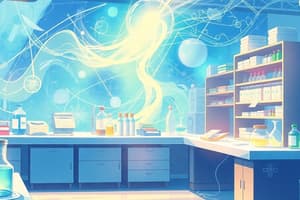Podcast
Questions and Answers
What is the main difference between systematic error and random error?
What is the main difference between systematic error and random error?
- Systematic error only occurs in quantitative analysis, random error does not.
- Only systematic error can be reduced with better equipment.
- Systematic error is consistent and predictable, while random error varies and is unpredictable. (correct)
- Both systematic and random errors are predictable.
A good equipment management policy in a laboratory has no real benefits.
A good equipment management policy in a laboratory has no real benefits.
False (B)
List two components of personal protective equipment that are essential in a laboratory.
List two components of personal protective equipment that are essential in a laboratory.
Gloves, Safety goggles
In analyzing QC failures, using _____ and Sigma-metric helps in identifying problem analytes.
In analyzing QC failures, using _____ and Sigma-metric helps in identifying problem analytes.
Match the following quality indicators with their descriptions:
Match the following quality indicators with their descriptions:
Which of the following are valid approaches to verify a QC failure? (Select all that apply)
Which of the following are valid approaches to verify a QC failure? (Select all that apply)
External Quality Control (EQC) often involves testing known samples.
External Quality Control (EQC) often involves testing known samples.
Which of the following are goals of quality control in the laboratory? (Select all that apply)
Which of the following are goals of quality control in the laboratory? (Select all that apply)
What is a common pre-analytic occurrence frequently seen in laboratories?
What is a common pre-analytic occurrence frequently seen in laboratories?
Bubbles in the reagent line are a source of systematic error.
Bubbles in the reagent line are a source of systematic error.
Name the two types of systematic errors.
Name the two types of systematic errors.
The path that can be assessed while a sample is moving through the laboratory is: __________.
The path that can be assessed while a sample is moving through the laboratory is: __________.
The most common statistics utilized in internal quality control as descriptive measures of a set of values include ____, ____, and ____.
The most common statistics utilized in internal quality control as descriptive measures of a set of values include ____, ____, and ____.
Match the following laboratory processes with their significance:
Match the following laboratory processes with their significance:
How is laboratory information management primarily concerned?
How is laboratory information management primarily concerned?
Match the following types of errors with their descriptions:
Match the following types of errors with their descriptions:
Which factors are potential sources of systematic error? (Select all that apply)
Which factors are potential sources of systematic error? (Select all that apply)
What is the primary purpose of Levey-Jennings charts in laboratory quality control?
What is the primary purpose of Levey-Jennings charts in laboratory quality control?
Once a laboratory sample is correctly processed, the analysis phase can proceed without further checks.
Once a laboratory sample is correctly processed, the analysis phase can proceed without further checks.
Internal Quality Control involves analyzing results after patient samples have been analyzed.
Internal Quality Control involves analyzing results after patient samples have been analyzed.
What is the most effective investigational technique for occurrence management?
What is the most effective investigational technique for occurrence management?
Flashcards
Quality Control (QC) Verification
Quality Control (QC) Verification
The process of ensuring that laboratory tests produce reliable results.
External Quality Control
External Quality Control
Statistical QC using known values to assess measurement bias.
Laboratory Sample Path Assessment
Laboratory Sample Path Assessment
Evaluates the procedure from sample collection to testing.
Pre-Analytic Occurrences
Pre-Analytic Occurrences
Signup and view all the flashcards
Levey-Jennings Charts
Levey-Jennings Charts
Signup and view all the flashcards
Goals of Laboratory Quality Control
Goals of Laboratory Quality Control
Signup and view all the flashcards
Systematic Errors
Systematic Errors
Signup and view all the flashcards
Random Errors
Random Errors
Signup and view all the flashcards
Effective Investigational Techniques
Effective Investigational Techniques
Signup and view all the flashcards
Precision vs. Accuracy
Precision vs. Accuracy
Signup and view all the flashcards
Quality Indicators
Quality Indicators
Signup and view all the flashcards
Sources of Contamination
Sources of Contamination
Signup and view all the flashcards
Basic Laboratory Safety Equipment
Basic Laboratory Safety Equipment
Signup and view all the flashcards
Internal Quality Control Overview
Internal Quality Control Overview
Signup and view all the flashcards
Descriptive Statistics
Descriptive Statistics
Signup and view all the flashcards
Targeting Analytes for Investigation
Targeting Analytes for Investigation
Signup and view all the flashcards
Laboratory Customer Satisfaction Indicators
Laboratory Customer Satisfaction Indicators
Signup and view all the flashcards
Routes of Chemical Entry
Routes of Chemical Entry
Signup and view all the flashcards
Benefits of Good Equipment Management
Benefits of Good Equipment Management
Signup and view all the flashcards
Sampling and Preparation Steps
Sampling and Preparation Steps
Signup and view all the flashcards
Study Notes
Quality Control Verification Approaches
- Excluding a QC point and continuing work may overlook potential issues.
- Repeating QC tests until acceptable results are achieved can delay workflow.
- Using a fresh aliquot for QC ensures reliability and eliminates prior sample issues.
- Verifying the integrity of QC materials is vital to prevent errors from product degradation.
External Quality Control
- External QC is recognized as statistical Quality Control.
- Values of External QC samples are known prior to testing, facilitating comparison.
- The primary goal is to evaluate the bias introduced by measurement procedures.
Laboratory Sample Path Assessment
- The assessment starts at the clinic sample collection area.
- Proper labeling of samples is essential to prevent identification errors.
- Sample processing area must adhere to protocols to ensure sample integrity.
- Correct storage of reagents or test kits is critical for accurate results.
Laboratory Customer Satisfaction Indicators
- Laboratory tests register provides insight into service demand.
- Quality indicators reflect performance and satisfaction levels.
- Reviewing test results helps identify gaps in expectations versus delivery.
- External audits assess overall operational integrity and customer satisfaction.
Pre-Analytic Occurrences
- Improper sample collection and storage are common and affect results.
- Appropriate labeling ensures traceability and reduces errors.
- Transport samples under specified conditions to maintain integrity.
- Storage conditions for reagents or test kits must align with guidelines.
Laboratory Information Management
- Focuses on documenting complaints for quality enhancement.
- Maintains sample logs and records for tracking and compliance.
- Conducts root cause analysis to address issues effectively.
- Monitors critical services inventory to prevent disruptions.
Levey-Jennings Charts
- Used to monitor QC data over time and identify trends or shifts in results.
- Useful for detecting systematic errors and outliers in measurement processes.
- Helps maintain ongoing quality assurance in laboratory operations.
Goals of Laboratory Quality Control
- Detecting and correcting errors is essential for reliable results.
- Avoiding erroneous result reporting safeguards patient care.
- Identifying the root causes of errors enhances operational efficiency.
- Alerting providers of abnormal results ensures timely intervention.
Routes of Chemical Entry
- Chemicals can enter the body through inhalation.
- Absorption through skin contact is a common exposure pathway.
- Percutaneous inoculation poses risks in handling substances.
- Ingestion can occur if proper safety protocols are not followed.
Sources of Contamination
- Air conditioning vents can disperse contaminants in the laboratory.
- Aerosols created by laboratory processes can pose airborne risks.
- Animal cages may harbor pathogens that contaminate the environment.
- Sick employees can contribute to the spread of infectious agents.
Descriptive Statistics in Internal Quality Control
- Coefficient of variation indicates relative variability among data points.
- Mode identifies the most frequently occurring value in a dataset.
- Mean provides an average measurement for establishing reference ranges.
- Standard deviation reflects data spread and consistency of test results.
Internal Quality Control Overview
- Internal QC is conducted alongside patient samples to detect immediate issues.
- Analysis performed after patient sampling focuses on retrospective quality checks.
- Identifies operational problems in real-time to maintain quality standards.
- Evaluates measurement precision to ensure reliability of test results.
Types of Systematic Errors
- Random and constant errors are two main systematic error types.
- Allowable and proportional errors help frame acceptable ranges and calibration.
Sources of Systematic and Random Errors
- Systematic errors can arise from erroneous sample labeling.
- Environmental factors like unstable conditions contribute to random errors.
- Slow deterioration of reagents may lead to inconsistent test results.
Effective Investigational Techniques
- Analysis of all QC data provides a comprehensive view of performance.
- Customer surveys offer direct feedback regarding laboratory services.
- Employee performance evaluations can highlight training needs.
- Root cause analysis is crucial for effective occurrence management.
Sampling and Preparation Steps in Quantitative Analysis
- Following stringent protocols during sampling ensures reliability.
- Thorough preparation of samples maximizes the accuracy of analytical results.
Differences Between Systematic and Random Errors
- Systematic errors are consistent and can bias results in one direction.
- Random errors fluctuate and may arise from uncontrolled variables.
Benefits of Good Equipment Management Policies
- Ensures optimal performance and longevity of laboratory instruments.
- Reduces the likelihood of equipment failure impacting results.
- Facilitates timely maintenance and calibration to enhance accuracy.
Basic Laboratory Safety and Personal Protective Equipment
- Lab coats protect skin and clothing from chemicals.
- Gloves safeguard hands from hazardous materials.
- Safety goggles shield eyes from splashes and irritants.
- Face shields provide additional protection during high-risk procedures.
Targeting Analytes for Investigation
- Analyze SEc and Sigma-metric values for performance discrepancies.
- Higher SEc values indicate areas requiring further investigation for precision improvement.
Quality Indicators
- Turnaround time for test results.
- Accuracy of reported test results.
- Compliance with safety standards.
- Efficiency of sample processing.
- Customer complaints and feedback.
- Staff training and competency assessments.
- Equipment maintenance schedules.
- External audit findings.
Precision vs. Accuracy
- Results can be precise if repeated measurements yield consistent values.
- However, accuracy may be lacking if those consistent values deviate from the true or expected value.
Studying That Suits You
Use AI to generate personalized quizzes and flashcards to suit your learning preferences.




